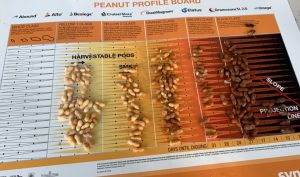Jay Capasso, UF/IFAS Columbia County Extension, Sylvia Willis, UF/IFAS Suwannee County Extension (An Equal Opportunity Institution)
Determining when to harvest peanuts is a difficult and important economic decision for growers. Peanuts are an indeterminate crop, meaning they flower, set fruit, and maintain vegetative growth throughout the season. Since they are continuously setting fruit, peanuts do not mature evenly throughout a field and are harvested at the end of the season at various stages of maturity. This is a different scenario compared to determinate crops, such as corn or wheat, which mature at roughly the same time throughout a field. Peanut growers aim to dig their crop when most of their peanuts are optimally mature to gain the most yield.
Every year, around the end of the season, peanut growers often contact their local extension agents to “pod blast” peanuts to help determine peanut maturity and when to dig. Pod blasting refers to a method of determining peanut maturity that involves utilizing a pressure washer to blow off the outer peanut shell (exocarp). Around 180 – 200 peanuts are collected from 4-5 plants representatively sampled from different locations in a field. Removing the outer hull exposes the color of the underlying mesocarp in the saddle area of the peanut pod. Peanut maturity is determined by sorting peanut pods by color based on the Maturity Profile Board developed by Williams and Drexler (1981). Other methods of gauging peanut maturity involve utilizing a knife, instead of a pressure washer, to scrape off the outer shell to observe the interior color or using the shellout method. The shellout method involves splitting open peanut shells to observe the interior color of the pods. Darker interior color due to aged veins and cell death indicates maturity.
The crop is generally considered optimally mature after 70% or more of the pods are observed to be mature, meaning they are in brown or black color classes on the Maturity Profile Board. Utilizing a pressure washer is a helpful tool when examining larger, more representative samples of a field. The Maturity Profile Board helps predict when the crop will reach optimal maturity through the observation of the number peanut pods in each color class. These tools can also be useful in comparing maturity levels between different fields, helping growers decide which fields should be dug first.

Pod blasting can be a subjective tool because individuals perceive and interpret the color of the mesoscarp differently. It is helpful to observe pod blasted peanuts in consistently well-lit environments. Growers should also consider the vine health of their crop and the recommended days after planting of their peanut variety when determining digging date.
For more information on pod blasting see video below:
 0
0
